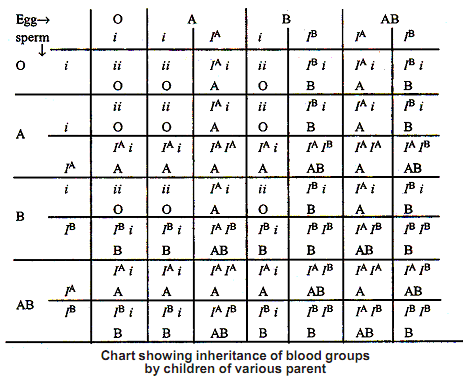MULTIPLE ALLELES
(i) More than two alternative forms (alleles) of a gene in a population occupying the same locus on a chromosome or its homologue are known as multiple alleles.
(ii) There are more than two alleles of the same gene.
(iii) All multiple alleles occupy the corresponding loci in the homologous chromosomes. (iv) A chromosome or a gamete has only one allele of the group.
(v) Any one individual contains only two of the different alleles of a gene, one on each chromosome of the homologous pair carrying that gene.
(vi) Multiple alleles express different alternatives of a single trait.
(vii) Different alleles may show codominance, dominance - recessive behaviour or incomplete dominance among themselves.
Example :-
Human Blood Groups
(i) ABO blood group system in human beings is an example of multiple alleles.
(ii) Human beings have four blood groups or blood group phenotypes - A, B, AB and O.
(iii) The blood groups are determined by two types of antigens present in the surface coating of red blood cells-A and B.
(iv) Blood group A persons have antigen A, group B have antigen B, AB have both antigens while blood group O
persons do not carry antigen in the coating of their erythrocytes.
(v) Presence, absence and type of antigens are determined by three immunogen alleles IA, IB and i. (vi) IA forms antigen A, IB antigen B while allele i is recessive and does not form any antigen.
(vii) Both IA and IB are dominant over i, but not over each other.
(viii) When both IA and IB are present in a person, both the alleles are able to express themselves forming antigens A and B. Such alleles which are able to express themselves in the presence of each other are called codominant. Thus blood group alleles show both codominant and dominant recessive relationships (IA = IB >> i).
(ix) A human being carries two of the three alleles, one from each parent. The maximum number of possible genotype is six for the four phenotypes. The phenotypes are tested by two antisera, anti-A and anti-B.

|
S .No.
|
Blood Group P he notype
|
Ge notype
|
Re a ction w ith Anti-A Anti-B
|
|
1
|
O
|
ii
|
- -
|
|
2
|
A
|
IA IA , IA i
|
+ -
|
|
3
|
B
|
IB IB, IB i
|
- +
|
|
4
|
AB
|
IA IB
|
+ +
|
(x) Blood groups being a hereditary character, the knowledge of blood groups of the parents can give information about the possible blood groups of children and vice versa.